
Prisons have held lawbreakers for as long as there have been laws to break. Facilities come and go as centuries pass, but the most notoriously scary historical prisons tend to haunt the pages of our history books with tales of unspeakable suffering, violence, and crime. They contributed to war efforts, impacted revolutions, and affected the history of the cities and countries that surrounded them.
The concept of prisons as we know them today is relatively modern. In antiquity, jails served less as places of penitence and more as a purgatory before the final judgment of guilt, which was often punished either by enslavement or execution. Before the mega jails and super-maxes of today, historical prisons took on many forms, from isolated islands to underground dungeons. Excluding any prison that is currently open and also the horrifically depressing sub-genre of concentration camps, this list reveals some of the scariest prisons in history.
Pitești Prison, Romania
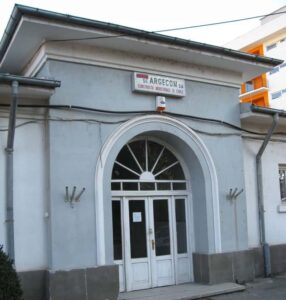
Photo: BiruitorulWikimedia Commons (Public Domain)
Pitesti was a Communist prison built in Romania, most famous for its intense and brutal brainwashing experiments. Operating from 1949-1951, the Pitesti Experiment attempted to “re-educate” wealthy intellectuals, bourgeois landowners, religious rebels, and political dissidents through psychological torture. Prisoners were malnourished and subjected to intentionally humiliating punishments.
In an effort to get prisoners to turn on one another, guards made prisoners torture each other by spitting and urinating in each other’s mouths, among other even more disgusting things.
The Mamertine, Italy
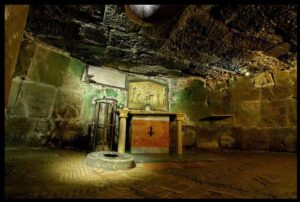
Photo: RickydavidflickrCC-BY-NC-ND 2.0
In Ancient Rome, the Mamertine’s violence wasn’t just brutal – it was biblical. A dank underground jailhouse, the Mamertine played host to two of Christianity’s most famous characters. St. Peter and St. Paul; both spent time locked up in the dungeons of Mamertine, imprisoned there by Roman Emperor Nero.
In use since the 8th century BCE, the prison contained two floors of underground cells, one on top of the other, with the lower levels only accessible through holes in the upper levels. After torturous treatment and lack of food led to the deaths of many of the prisoners, guards disposed of their bodies in the Cloaca Maxima, AKA the Roman sewer.
Prison At Urga, Mongolia
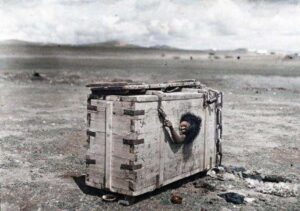
Photo: Stéphane Passet/Public DomainWikimedia Commons
When explorer Roy Chapman Andrews, future director of the American Museum of Natural History, arrived at the prison in Urga, Mongolia, in 1918, he couldn’t believe his eyes. Taken on a tour of the town’s jail, he saw that the accommodations for prisoners in Urga were worse than any he had ever seen or studied before – because the prisoners essentially lived in coffins.
Housed in four-foot by three-foot boxes, prisoners could reach through a single six-inch hole to receive their food rations or blankets in the winter, when they got any, which was rare. Guards only cleaned the boxes every few weeks and as such, a prisoner very rarely saw the outside of their “cell.” Prisoners’ limbs atrophied from lack of movement, although many didn’t live long enough to see this happen.
Devil’s Island, French Guiana

Photo: CayambeWikimedia CommonsCC BY-SA 4.0
Potentially the most feared penal colony in history, Devil’s Island saw 60,000 prisoners sail in its direction and only 2,000 make it out alive. An isolated island off the coast of French Army Guiana in the Atlantic ocean, Napoleon III and the French chose the island in 1852 because it was nearly impossible to escape. Guards worked prisoners nearly to death during the day, building unending roads to nowhere and clearing trees. At night, they were shackled and left in the dark to be bitten by vampire bats that waited in the rafters.
Some prisoners were kept in “bear pits” – holes dug into the ground and covered at the top by iron bars. The island’s two most well-known residents were Alfred Dreyfus, a French Captain falsely convicted of treason, and Henri Charrière, an inmate who escaped the island and wrote a memoir about his time there. The book, Papillon, was adapted into a movie starring Steve McQueen and Dustin Hoffman.
Carandiru Penitentiary, Brazil

Photo: Christopher KirkflickrCC-BY-NC-ND 2.0
Despite its nearly century-long infamous history, Carandiru Penitentiary in São Paulo, Brazil, is most notorious for the events of a single day. During the Carandiru Massacre on October 2, 1992, police took the lives of over 100 inmates in about 30 minutes. The events unfolded when an argument about a football match between two inmates devolved into a fight between rival gangs, which in turn sparked a prison riot.
In the overcrowded prison that held more than twice its inmate capacity, the riot raged on for three hours until police entered the complex and began to fire. According to witnesses, police shot inmates at close range behind locked cell doors and unleashed dogs on the wounded. It took 20 years for any of the police involved to be punished for their brutality against the prisoners.
Hỏa Lò Prison, Vietnam
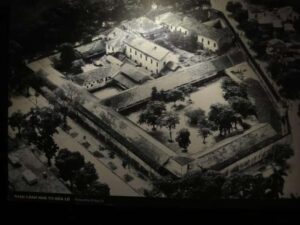
Photo: gforbesflickrCC-BY-NC 2.0
Originally opened by French colonists in 1896 to house Vietnamese rebels, the Hỏa Lò Prison ultimately became famous by a different name: the Hanoi Hilton. During the Vietnam War, Hỏa Lò Prison imprisoned American POWs like Congressman Sam Johnson and Senator John McCain, who tried to commit suicide twice during his stay. The length of the Vietnam War led to long periods of imprisonment for many POWs, some staying at the Hanoi Hilton for eight years or more.
While there, POWs were beaten, tied up by their wrists, hung from meat hooks, forced into extended solitary confinement, and used in propaganda films. They finally made it home after the Paris Peace Accords set them free and the war ended.
Camp Sumter, United States
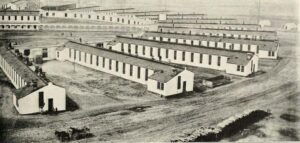
Photo: Internet Archive Book ImagesflickrNo known copyright restrictions
The distinction of being the “deadliest landscape of the Civil War” is quite a notorious achievement. That reward doesn’t go to the battlegrounds of Antietam in Maryland or Gettysburg in Pennsylvania, but to Andersonville, GA. At Camp Sumter Military Prison in Andersonville, the Confederate army imprisoned more than 45,000 Union troops during the last year of the Civil War.
Almost 13,000 of those troops lost their lives; most of the deaths were caused by disease and severe overcrowding. After the war ended, conditions at Andersonville so appalled the US government that officials sentenced the head of the prison, Captain Henry Wirz, to death.
Robben Island, South Africa

Photo: ludiPixabayCC0 1.0
Infamous for its most famous resident, Nelson Mandela, Robben Island’s history is as broad as it is scary. The Dutch originally founded the prison in the 17th century during their colonization of South Africa. Since that time, the island has changed hands multiple times and served many different purposes: political prison, whaling station, military outpost during World War II, and insane asylum.
According to Mandela’s autobiography, he and other prisoners worked in a lime quarry, where the constant glare of the sun on the rock caused permanent eye damage. They received little food and clothing and were subjected to racism on a daily basis. Upon Mandela’s arrival, prison guards greeted him with some insight into the island: “This is the Island! Here you will die!” He spent the next 18 years, from 1964 to 1982, fighting the oppression of Apartheid from a six-square-foot cell.
Tadmor Prison, Syria

Photo: Alessandra KocmanflickrCC-BY-NC-ND 2.0
Built in the 1930s in Syria by the French, Tadmor’s notoriety began 40 years later, during the rule of Hafez al-Assad. During Assad’s reign as President of Syria, Tadmor became a dumping ground for political dissidents, summarily subjected to torture and execution.
Here are some of the scariest atrocities reported at Tadmor:
Soldiers killed between 500 and 1,000 prisoners in one day.
Medical treatment was scarce, with guards telling inmates, “Only call us to collect bodies.”
Guards held a “reception party” for incoming inmates that involved hitting them up to 400 times.
Guards forced two inmates at a time to hold a third by his arms and legs and throw him across the room. When a man refused, he was beaten so severely that he died soon after.
An inmate described being ordered by guards to remove every pair of slippers, roughly 100, from the dormitory using only his mouth.
Inmates couldn’t lift their eyes from the ground and would distinguish nice guards from sadistic ones by the color of their boots.
Despite the prison’s closure in 2001, Tadmor made an appearance in the news in 2015 when ISIS took control of the building and demolished it.
Port Arthur, Australia
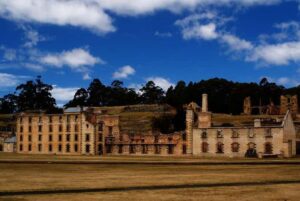
Photo: Modus InOperandiflickrCC-BY-NC-ND 2.0
In the 19th century, what did you do when you had massive amounts of criminals that you didn’t want to deal with anymore? If you were England, and your original dumping ground (the United States) just closed for business, you shipped them off to Australia. More specifically, you shipped them to Port Arthur.
After traveling thousands of miles from home, prisoners lived in harsh conditions, spending their time cutting timber, an exhausting job that was very lucrative for the prison.





